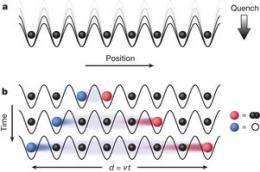January 26, 2012 report
Researchers observe speed of propagation in non-relativistic lattice

(PhysOrg.com) -- A team of researchers have devised a means for observing the speed with which quasiparticles can travel through an optical lattice. The experiment performed at the Max-Planck-Institut für Quantenoptik, as described in the paper the team has published in Nature, was a demonstration of a method that can be used to measure propagation through a non-relativistic lattice, a first of its kind.
One of the most commonly known principals in physics is that nothing can travel faster than the speed of light, but that number of course implies a vacuum, because light speed is slowed when passing through other materials. Because such a constant has been so helpful in so many studies, scientists would like to find a similar constant for the speed with which propagation moves through materials.
The principle of propagation can be seen by watching a game of pool. When a player pokes a cue ball with a stick, it rolls towards its target. At the start of the game, that target is a triangle of other balls all pressed firmly together. When the cue ball hits its target, the energy from it is transferred through the balls it strikes to those behind it, all in various directions based on the velocity and angle of the cue ball and the precise setup of all the other balls. The end result is propagation of energy with balls flying every which way.
Scientists would like to know if there is an actual speed limit in interactions that go on in materials that define propagation speed, because thus far, all they have to rely on is the theoretical speed limit described by the Lieb-Robinson bound.
To see if they could find out, the researchers set up an experiment that had far fewer variables. They chose a one-dimensional quantum gas made up of atoms set up in an optical lattice. To form the optical lattice, they used two counter-propagating laser beams to cause the atoms to cool and congregate in troughs, or potential minima. Then, by adjusting the lasers very quickly, they were able to create what is known as a quenched system, whereby excitations occur. In this case, those excitations are known as quasiparticles, which can travel through the lattice. Then, by measuring the distance a quasiparticle traveled in a certain amount of time, they were able to arrive at the speed with which they propagated through the lattice. This is the first time that the Lieb-Robinson bound has been quantified in an experiment.
The result isn’t a universal constant, like the speed of light, but it is a number that demonstrates a constant propagation speed though one material, which is groundbreaking news because it’s likely to lead to other studies that measure propagation speeds through other materials, which could have a profound impact on engineering efficient quantum channels which may help efforts to create quantum computers.
More information: Light-cone-like spreading of correlations in a quantum many-body system, Nature 481, 484–487 (26 January 2012) doi:10.1038/nature10748
Abstract
In relativistic quantum field theory, information propagation is bounded by the speed of light. No such limit exists in the non-relativistic case, although in real physical systems, short-range interactions may be expected to restrict the propagation of information to finite velocities. The question of how fast correlations can spread in quantum many-body systems has been long studied. The existence of a maximal velocity, known as the Lieb–Robinson bound, has been shown theoretically to exist in several interacting many-body systems (for example, spins on a lattice)—such systems can be regarded as exhibiting an effective light cone that bounds the propagation speed of correlations. The existence of such a ‘speed of light’ has profound implications for condensed matter physics and quantum information, but has not been observed experimentally. Here we report the time-resolved detection of propagating correlations in an interacting quantum many-body system. By quenching a one-dimensional quantum gas in an optical lattice, we reveal how quasiparticle pairs transport correlations with a finite velocity across the system, resulting in an effective light cone for the quantum dynamics. Our results open perspectives for understanding the relaxation of closed quantum systems far from equilibrium, and for engineering the efficient quantum channels necessary for fast quantum computations.
Journal information: Nature
© 2011 PhysOrg.com




















